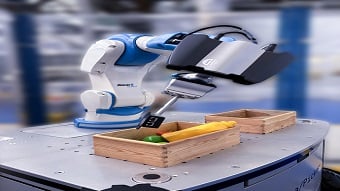5 strategies for systems integration in smart manufacturing
Jody Dascalu | May 10, 2024Integrating various systems and technologies is a critical aspect of smart manufacturing, aiming to enhance efficiency, productivity and flexibility in industrial operations. By adopting advanced integration techniques, manufacturers can significantly optimize their production processes. As industries increasingly move toward digitization and automation, understanding and implementing these strategies will be pivotal for businesses looking to maintain competitiveness in the evolving manufacturing landscape.
 Figure 1: Blue digital art. Source: Mahdi Bafande/Pexels
Figure 1: Blue digital art. Source: Mahdi Bafande/Pexels
1) Embracing the internet of things (IoT) for enhanced connectivity
The integration of IoT devices allows for the continuous monitoring of equipment performance, environmental conditions, and production processes. Sensors can detect and report anomalies in real time, enabling predictive maintenance and reducing downtime by addressing issues before they escalate into major problems. This real-time data exchange enhances operational efficiency, as managers and operators can make informed decisions based on current data, rather than relying on historical trends or manual inspections.
Key benefits:
- Real-time monitoring and predictive maintenance: IoT devices offer constant monitoring and quick anomaly detection, enabling predictive maintenance to reduce downtime and extend equipment life.
- Data-driven decision-making: IoT sensors provide immediate data, allowing for decisions based on current conditions rather than past data or manual inspections, improving efficiency and response. Data can also be stored and trends can be observed.
- Increased automation and productivity: IoT enhances automation in manufacturing, streamlining operations, reducing errors and boosting productivity through machine and system integration.
- Advanced analytics and artificial intelligence (AI) integration: IoT data underpins advanced analytics and AI, refining processes, enhancing efficiency, and fostering innovation for a market advantage.
Implementing IoT connectivity requires planning and consideration of network infrastructure, data management and device interoperability. Manufacturers must ensure that their IoT ecosystem is secure, scalable and capable of integrating with existing systems to fully realize the benefits of enhanced connectivity in smart manufacturing environments.
 Figure 2: IoT graphic. Source: ThinkGizmo/CC BY-NC-SA 2.0 DEED
Figure 2: IoT graphic. Source: ThinkGizmo/CC BY-NC-SA 2.0 DEED
2) Implementing interoperable standards and protocols
This strategy involves the adoption of universal, industry-recognized standards and communication protocols that ensure different devices, systems and software can communicate and work together effectively, regardless of their manufacturers or origins.
Interoperability is essential in modern manufacturing settings, where equipment and software from various vendors must interact without friction to create cohesive, efficient operations. By adhering to established standards and protocols, manufacturers can facilitate data exchange, synchronize operations and enhance the overall functionality of the production line.
Key benefits:
- Enhanced compatibility: Ensures that new and existing technologies can connect and communicate, reducing the risk of incompatibility issues that can disrupt production.
- Scalability: Makes it easier to add, upgrade or replace components within the manufacturing system without extensive modifications, supporting business growth and technological advancements.
- Reduced integration costs: Minimizes the need for custom integration solutions, as products designed to common standards are more likely to be compatible out of the box.
- Future-proofing: Protects investments in technology by ensuring that systems are more likely to remain relevant and integrable with future innovations.
Common standards and protocols in smart manufacturing might include OPC Unified Architecture (OPC UA), MTConnect, and the Industrial Internet Consortium (IIC) frameworks, among others. These standards cover various aspects of industrial operations, from data format and exchange to security and device communication.
 Figure 3: Workers climbing up stairs. Source: Sol/Unsplash
Figure 3: Workers climbing up stairs. Source: Sol/Unsplash
3) Investing in scalable and modular technologies
This strategy emphasizes the need for adaptability in manufacturing to meet evolving demands, technologies and business growth, minimizing the need for extensive overhauls. Scalable technologies allow for adjustments in capacity and functionality to align with the manufacturing process's changing needs, such as accommodating more users or handling larger data sets. Modular technologies offer the flexibility to easily integrate, replace or upgrade individual components, enabling manufacturers to customize systems to their specific requirements without a complete rebuild.
Key benefits:
- Flexibility: Manufacturers can adapt their production lines and processes to new products, variations in demand or changes in the industry without significant reconfiguration.
- Cost efficiency: Reduces the need for complete system replacements, allowing for incremental investments and minimizing disruption to operations.
- Innovation readiness: Facilitates the integration of new technologies or capabilities as they become available, keeping the manufacturing process at the cutting edge.
- Customization: Enables a high degree of customization, allowing systems to be tailored to the unique requirements of each manufacturing operation.
To effectively implement this strategy, manufacturers may conduct thorough assessments of their current and future needs, select technologies with proven scalability and modularity, and plan for regular reviews of their systems to identify opportunities for upgrades or expansions. Additionally, working with vendors who understand and support the need for scalable and modular solutions can help ensure that the selected technologies will serve the manufacturer's needs both now and in the future.
4) Developing a skilled workforce for digital transformation
This approach focuses on equipping employees with the necessary skills and knowledge to effectively manage and operate integrated digital systems and technologies. As manufacturing environments become increasingly reliant on advanced technologies such as IoT, AI and robotics, the need for a workforce that is proficient in these areas becomes increasingly important.
Key benefits:
- Continuous learning and training: Offering ongoing training to keep staff proficient in the latest smart manufacturing technologies and methods through varied learning formats.
- Cross-functional skill development: Promoting diverse skill acquisition in areas like IT, engineering and data analysis to enhance effectiveness in an integrated manufacturing setup.
- Partnerships with educational institutions: Forming alliances with academic bodies to craft specialized training programs, ensuring a steady influx of skilled workers for the manufacturing industry.
- Mentorship and knowledge sharing: Implementing mentorship schemes that allow seasoned employees to impart wisdom and digital competencies to the newer workforce, ensuring knowledge continuity.
By investing in the development of a skilled workforce, manufacturers can ensure that their employees are not only capable of operating within a digitally transformed environment but can also drive further innovation and efficiency improvements. This human-centric approach to digital transformation recognizes that technology alone is not enough; the full potential of smart manufacturing can only be realized when it is complemented by a workforce that is adept at leveraging these digital tools.
5) Adopting cloud computing for flexible data management
Adopting cloud computing for flexible data management is a strategic approach in smart manufacturing that leverages cloud technology to store, process and manage data across various systems and platforms. This strategy enables manufacturers to harness the power of scalable computing resources, enhanced collaboration and improved data accessibility, all of which are essential for effective systems integration in a dynamic manufacturing environment.
Key benefits:
- Scalability and elasticity: Cloud services adjust to manufacturing needs, optimizing resource use and data handling without the need for physical infrastructure.
- Centralized data management: Cloud platforms centralize data storage and management, enabling instant access and analysis from any location, and improving decision-making.
- Enhanced collaboration: Cloud-hosted data and apps boost team collaboration, allowing seamless information sharing across various sites, and aiding in planning and management.
- Improved data security and compliance: Cloud providers offer robust security and compliance, including encryption and audits, ensuring data safety beyond what individual manufacturers might achieve.
To effectively implement cloud computing in smart manufacturing, it's essential for manufacturers to conduct thorough assessments of their data management needs, select the right cloud service provider, and ensure that their cloud strategy aligns with overall business objectives. Additionally, addressing potential challenges such as data privacy, internet connectivity and integration with existing systems is crucial for a successful transition to cloud-based data management.
Forging the future of smart manufacturing
In the journey toward smart manufacturing, the strategic integration of systems and technologies — through IoT, interoperable standards, scalable technologies, skilled workforce development and cloud computing — enables manufacturers to enhance operations, maintain competitiveness and lead industrial evolution. This comprehensive approach ensures not only adaptation to current technological advancements but also shapes the future of manufacturing.
Author byline
Jody Dascalu is a freelance writer in the technology and engineering niche. She studied in Canada and earned a Bachelor of Engineering. As an avid reader, she enjoys researching upcoming technologies and is an expert on a variety of topics.




